Story at a glance:
- Most modern brick homes feature brick cavity walls or single-layer brick veneers rather than solid brick walls.
- Brick-built homes are durable, weather resistant, long-lasting, and help improve energy efficiency.
- Thin brick veneers are an affordable alternative to traditional whole-brick construction that also offer improved air and water barrier technology.
Bricks are among the world’s oldest man-made building materials, with the earliest known examples dating before 7,500 BCE. While the oldest mud and clay bricks look a bit different from our modern bricks, but they’re stronger and more aesthetically pleasing than ever.
Much like bricks themselves, brick homes have withstood the tests of time, weathering the ups and downs of human history, societal upheavals, and shifting climatic conditions with grace, enduring as a beloved staple and a crucial component of our nation’s ever-changing architectural landscape.
No matter the trends, brick architecture designs are a timeless, versatile, and sustainable option.
What is a Brick Home?
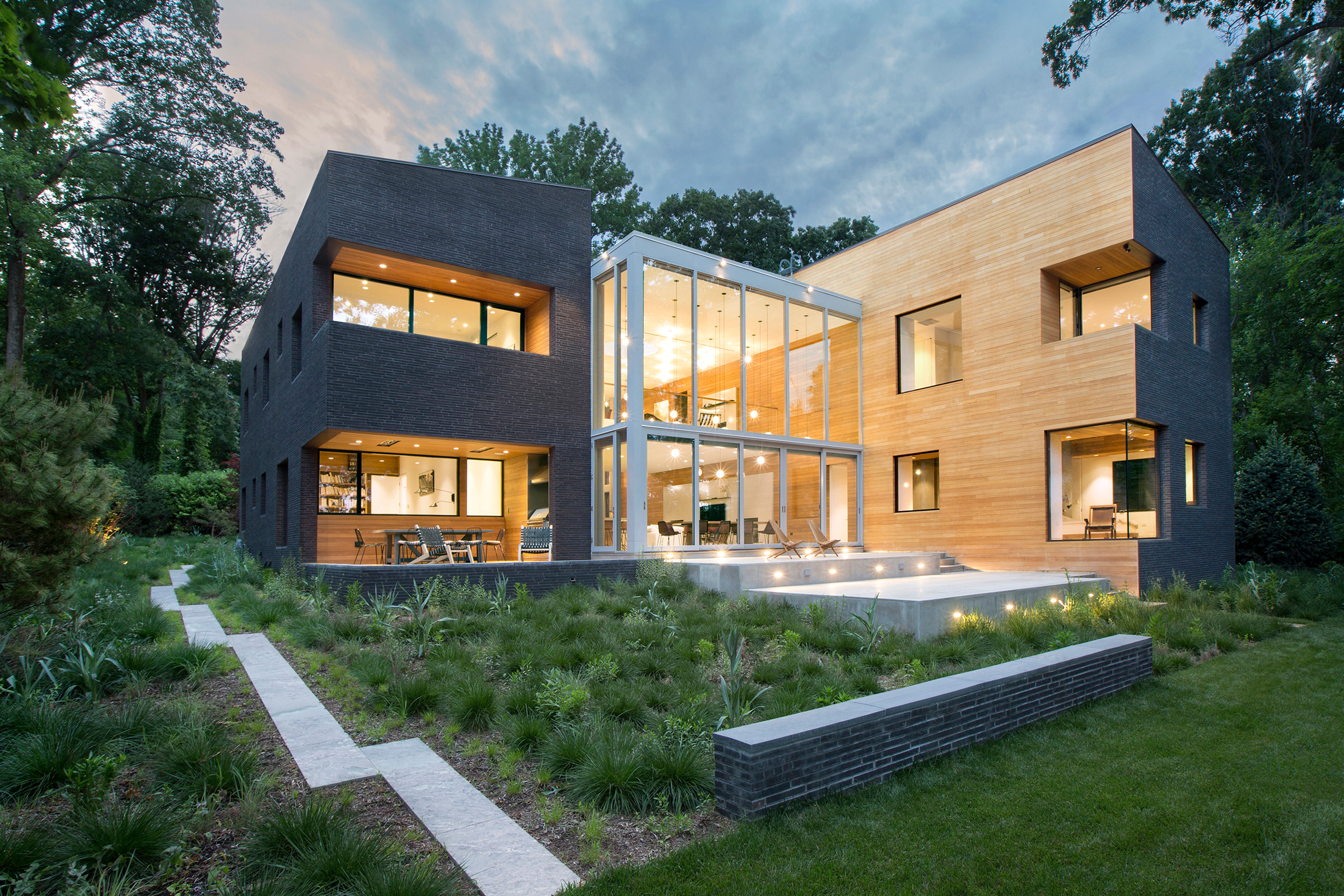
Brick homes primarily feature brick—be it in the form of solid brick walls, brick cavity walls, or brick veneers—in their construction. Photo by Tom Grimes
A brick home, or brick-built home, describes any house whose walls are constructed primarily from clay brick laid in courses and mortared in place. Older brick homes typically feature solid brick or double-brick walls that bear the home’s structural load and would be brick from floor to ceiling, inside and out. Solid brick homes are incredibly strong and resilient, but require that insulation be added to the exterior, interior, or both to effectively regulate temperatures.
Modern brick homes, on the other hand, rarely feature solid brick walls but instead use one of two systems: brick cavity walls or brick veneer. Brick cavity walls are a type of structural wall and consist of two single-layer brick walls—one facing outward and the other facing inward—separated by a cavity, into which some form of insulation is added to improve the wall’s energy efficiency and reduce moisture infiltration.
The other option, brick veneer, refers to either a single layer of exterior-facing brick wall attached to the home via metal ties or manufactured thin brick panels affixed directly to an exterior or interior wall. Homes that employ a brick veneer do not rely on the bricks for structural support, but instead use a traditional wood or steel framing system to shoulder the structure’s compressive load.
The Advantages & Disadvantages of Brick Homes
Like all houses, brick homes have their fair share of both advantages and disadvantages that can make or break the decision to buy or build one.
Advantages
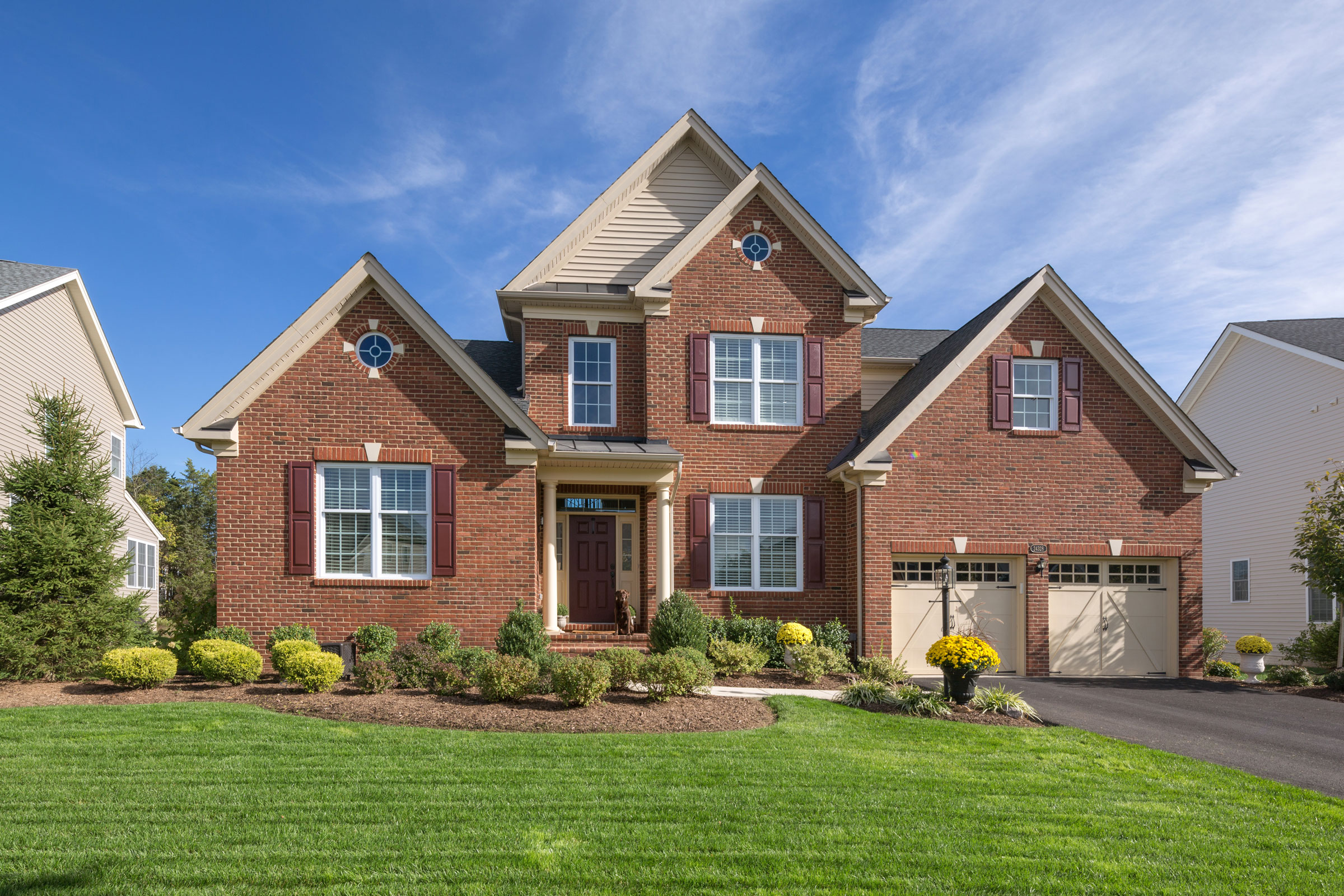
Brick homes offer a range of benefits, including high resistance to extreme weather, fires, and pests, as well as improved energy efficiency and increased home value. Photo by Donna Chiarelli
Generally speaking the benefits of brick homes significantly outweigh their disadvantages—which should come as no surprise considering their enduring popularity.
Strong, Durable & Long-Lasting
While it may not have the same compression strength of concrete or steel, brick is nevertheless an incredibly strong building material and is more than capable of shouldering the compression loads of one-, two-, and even three-story homes. This strength comes as a result of the manufacturing process, which involves heating the bricks to an extremely high temperature that in turn fuses the clay particles together, creating a strong molecular bond that effectively transforms the bricks into hard metamorphic rocks.
High-quality bricks are also extremely durable and are capable of withstanding extreme weather events better than stick-built homes. Because of this durability, structural brick homes are less likely to suffer damages and are often cheaper to insure due to there being less risk involved. A well-built and properly maintained brick home is capable of lasting well over 100 years, with research from the Clay Brick Association suggesting that brick houses have an average lifespan of 500 years.
Energy-Efficient
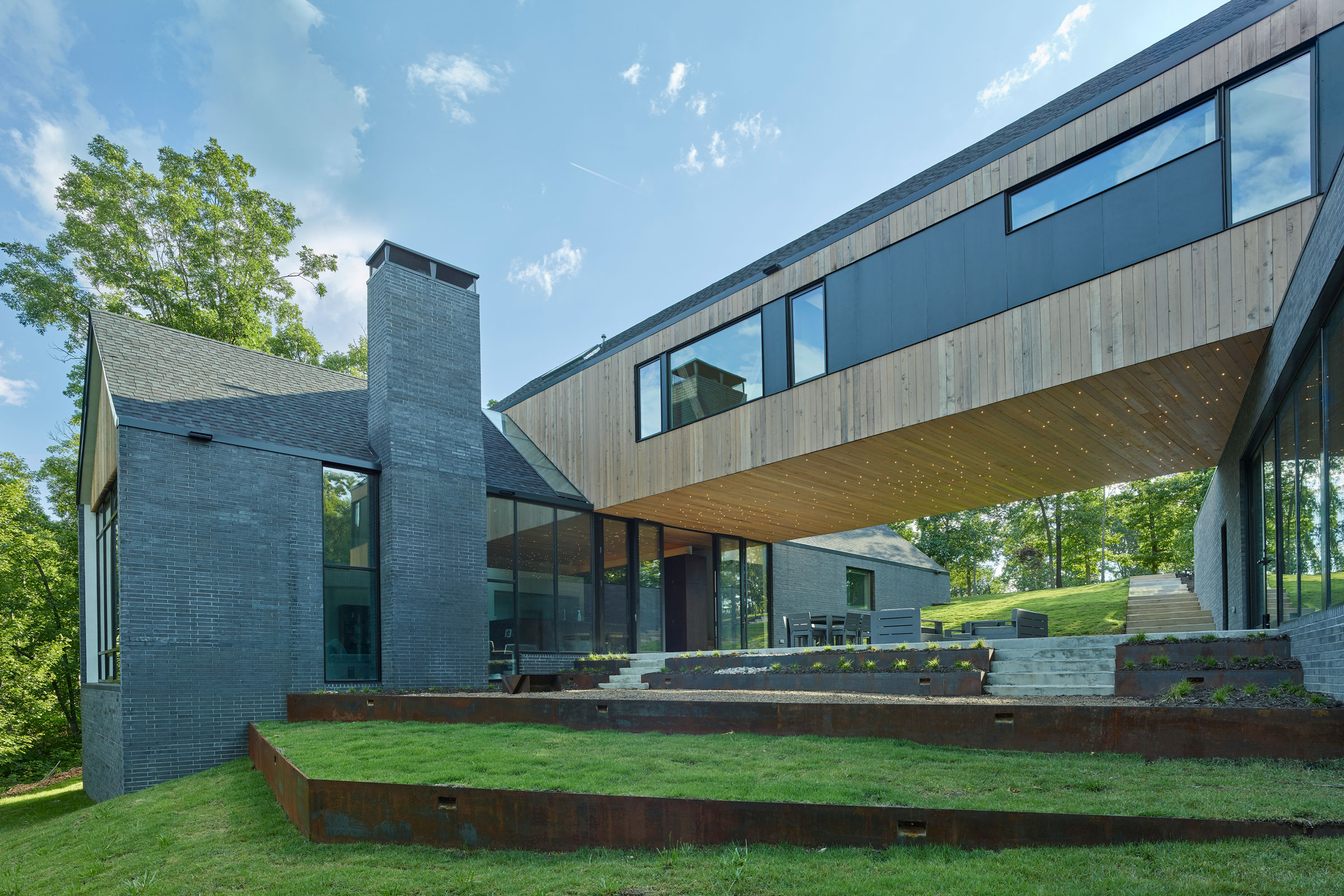
When paired with adequate insulation, brick homes offer improved energy efficiency than the average home. Photo by Tim Hursley
As long as they feature proper insulation, brick homes are incredibly energy-efficient thanks to clay’s high thermal mass. This characteristic means brick walls are able to reflect and retain heat extremely well, making it easier to passively regulate interior temperatures without the excessive use of mechanical heating and cooling.
“Bricks have inherent thermal properties because the clay from which they are made is a high-density material,” Tim Leese, director of marketing for Glen-Gary, a premier brick and stone manufacturer in the US, previously wrote for gb&d. “They can absorb and store heat energy in both the summer and winter to better cool and heat a home, in turn helping to minimize large peaks and dips as a home’s temperature fluctuates, instead averaging out extremes.”
Incredibly Resilient
Brick is an exceptionally resilient building material, one that is considered to be almost completely weather- and stormproof. “As a result it’s better able to withstand the diverse weather conditions across North America from natural disasters to extreme heat in fire prone regions,” writes Leese. “Since brick doesn’t contain any organic plant matter, it’s also resistant to pests and won’t decay in hot or humid weather conditions.”
Because they are fired under extremely high temperatures during the manufacturing process, bricks are also highly resistant to fire damage, making it an ideal building material for homes in wildfire-prone regions. Thanks to the non-combustible nature of clay, even bricks that have been exposed to fires typically do not suffer structural damage, allowing them to be reused afterwards.
Varied Design Options
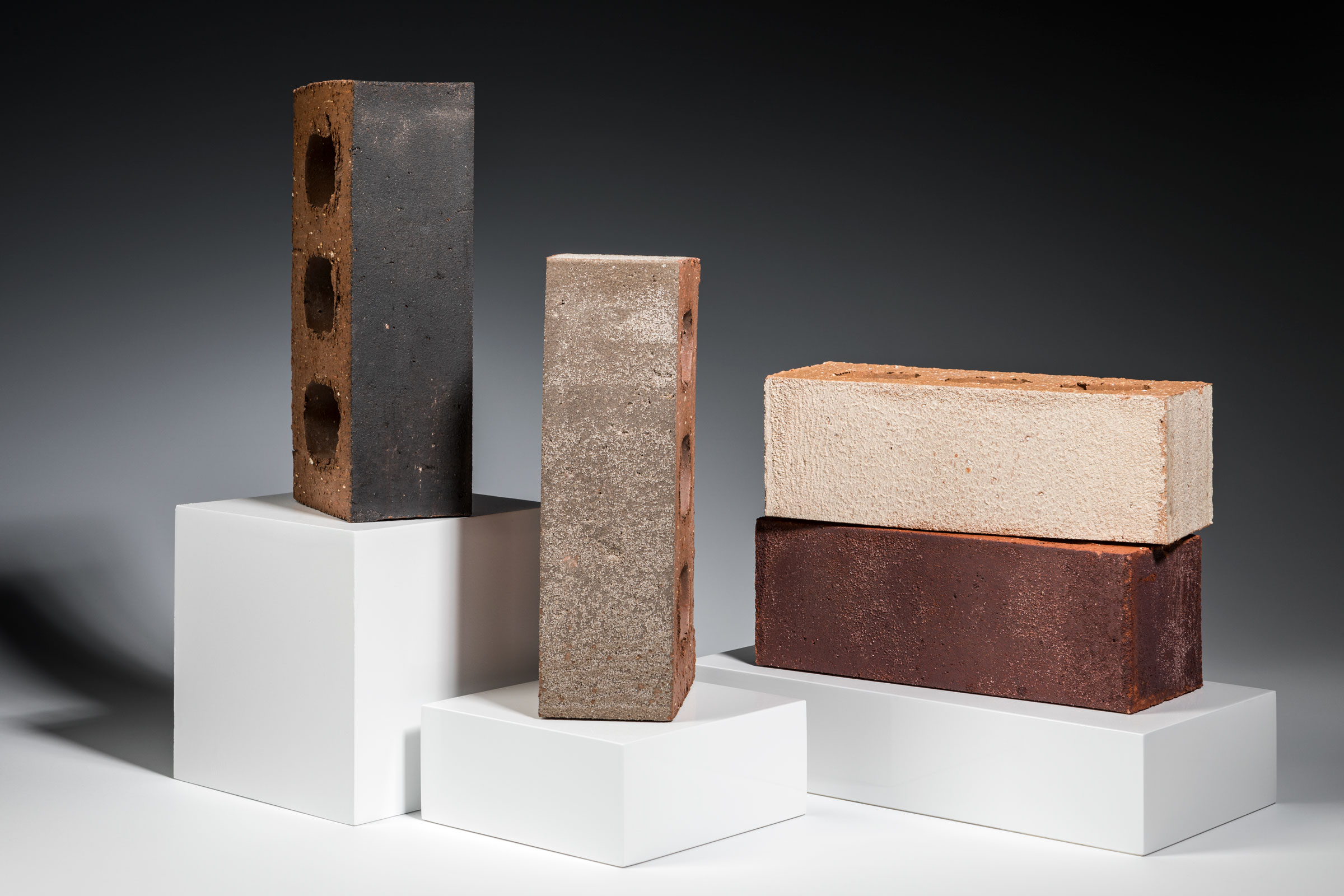
The Endless Skies Series. Photo courtesy of Glen-Gery
While most people think of brick homes as only coming in various shades of red to brown, the truth is that modern brick technology supports an extremely wide variety of colors—as well as textures, sizes, and finishes—allowing for greater customizability than ever before. The Glen-Gery Corporation, for example, is a leader in the brick industry, offering hundreds of different brick styles suitable for any desired aesthetic.
Glen-Gery’s Endless Skies Series includes four colors—dusky black Night Smoke, brownish-gray Taupe Horizon, sandy Sunset Sun, and deep red Tuscan Sun.
Increased Home Value & ROI
Brick homes also retain their value better than homes with vinyl, wood, or fiber cement siding, in large part thanks to their low maintenance requirements, improved energy efficiency, and high durability. According to Glen-Gery, brick homes sell for approximately 8% more than comparably-sized homes built from other materials, with brick exteriors helping to facilitate a higher ROI. In addition to selling for a higher price, brick homes also tend to sell faster, too.
Easily Recycled & Reused
Because bricks are strong, durable, and resilient, they can easily be reused during renovations or recycled after demolition to be used in new construction projects. In the event that a brick does break or become otherwise damaged to the point it is no longer fit for structural construction, it can still be repurposed for landscaping/hardscaping or broken down and recycled to make new bricks. This significantly reduces a structure’s overall carbon footprint and embodied carbon.
Disadvantages
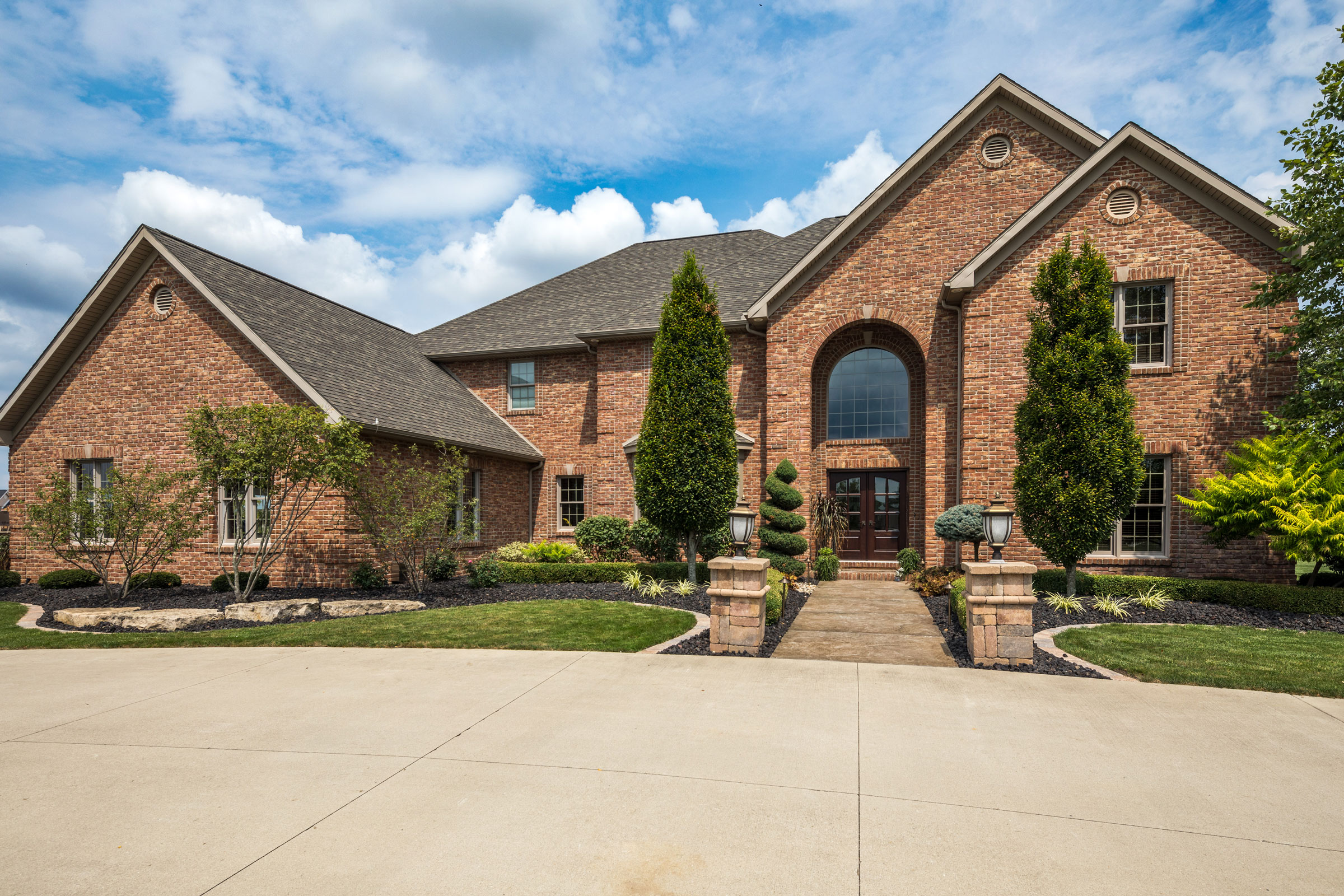
Compared to traditional stick-built homes, brick homes are more expensive to build, require highly skilled laborers, and take longer to construct. Photo by Donna Chiarelli
Despite their many advantageous qualities, brick homes are not without their disadvantages, either. Fortunately, these disadvantages are outweighed by the long-term benefits of brick construction.
Upfront Costs
Similar to stone houses, brick-built homes have higher upfront costs than conventional stick-built homes, both due to the materials used in their construction and the labor requirements they necessitate. Building a custom brick house costs on average $300,000—or roughly $20,000 more than constructing a standard home clad with vinyl siding—with approximately half of those expenses going towards labor.
In general, however, these higher upfront costs are justified by the durability, low maintenance requirements, and energy-efficiency associated with brick houses.
Requires Skilled Construction
Like all masonry work, building with brick is an extremely time-consuming and labor-intensive activity that requires expert working knowledge of the materials themselves. As such, brick houses are typically built by highly skilled bricklayers and masons rather than teams of contractors, which can drastically increase both the overall construction time and costs.
Longer Construction Times
Because bricklayers must lay each brick individually and allow time for the mortar to cure, building a brick home typically takes longer than constructing a conventional wood-framed home.
What is Thin Brick Veneer?
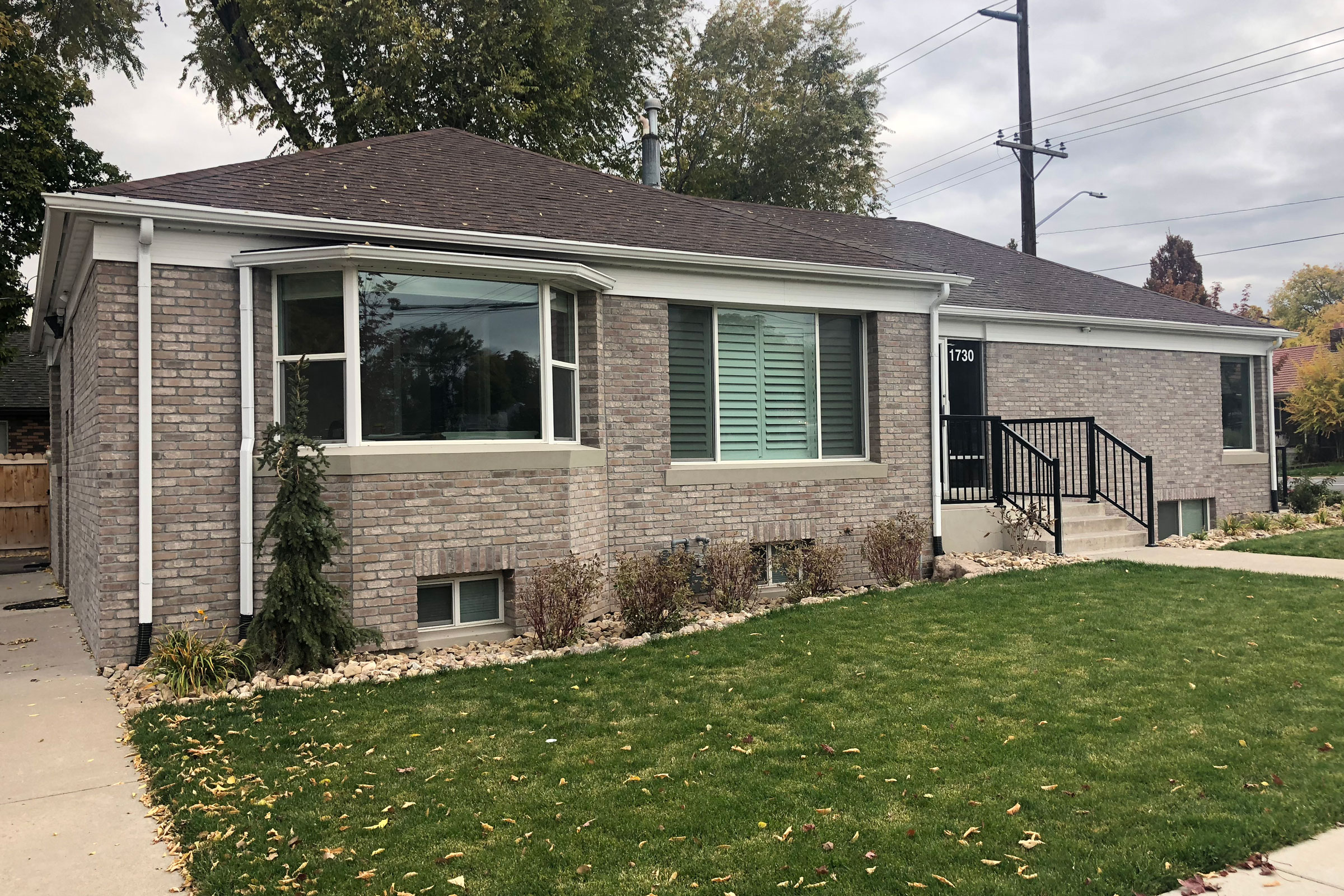
This highly efficient home uses the Old Mill Panel+ System. Whether you’re building new or remodeling, the Panel+ System is simple to include in your design. Courtesy of Old Mill Brick
There is another way to enjoy the aesthetics of brick without having to spend an exorbitant amount on materials and labor: You could opt for thin brick veneer. Thin brick veneer is an architectural product designed to mimic the appearance of brick construction without actually using solid bricks. Instead, thin brick veneer is formed as panels featuring several real brick faces—typically no more than three-quarters-of-an-inch to 1 inch thick—that are then adhered to an existing wall system.
Old Mill Brick is a leading manufacturer of thin brick veneer solutions designed to provide the aesthetic appeal of brick construction at a much lower price. The company offers a range of thin brick veneer styles and patterns, all of which use their patented Brickwebb mesh-mounting system that makes installation quick and easy.
When paired with their Panel+ assembly system—which offers anywhere from R-5 to R-20 insulation value and features a drainage plain, ventilation channels, and an air barrier system—Old Mill’s thin brick veneers help homes meet continuous insulation and air/water barrier requirements set forth in the International Building Code and International Energy Conservation Code.
“Our products comply with numerous codes as well as being the easiest and most cost-effective way to get a job done anyway,” John Striednig, vice president of commercial operations at Old Mill Brick, told gb&d in a previous article. “If you have a high-performance option that costs less than the others and offers the additional benefit of sustainability, why would you use anything else?”
Brick vs Thin Brick Veneer
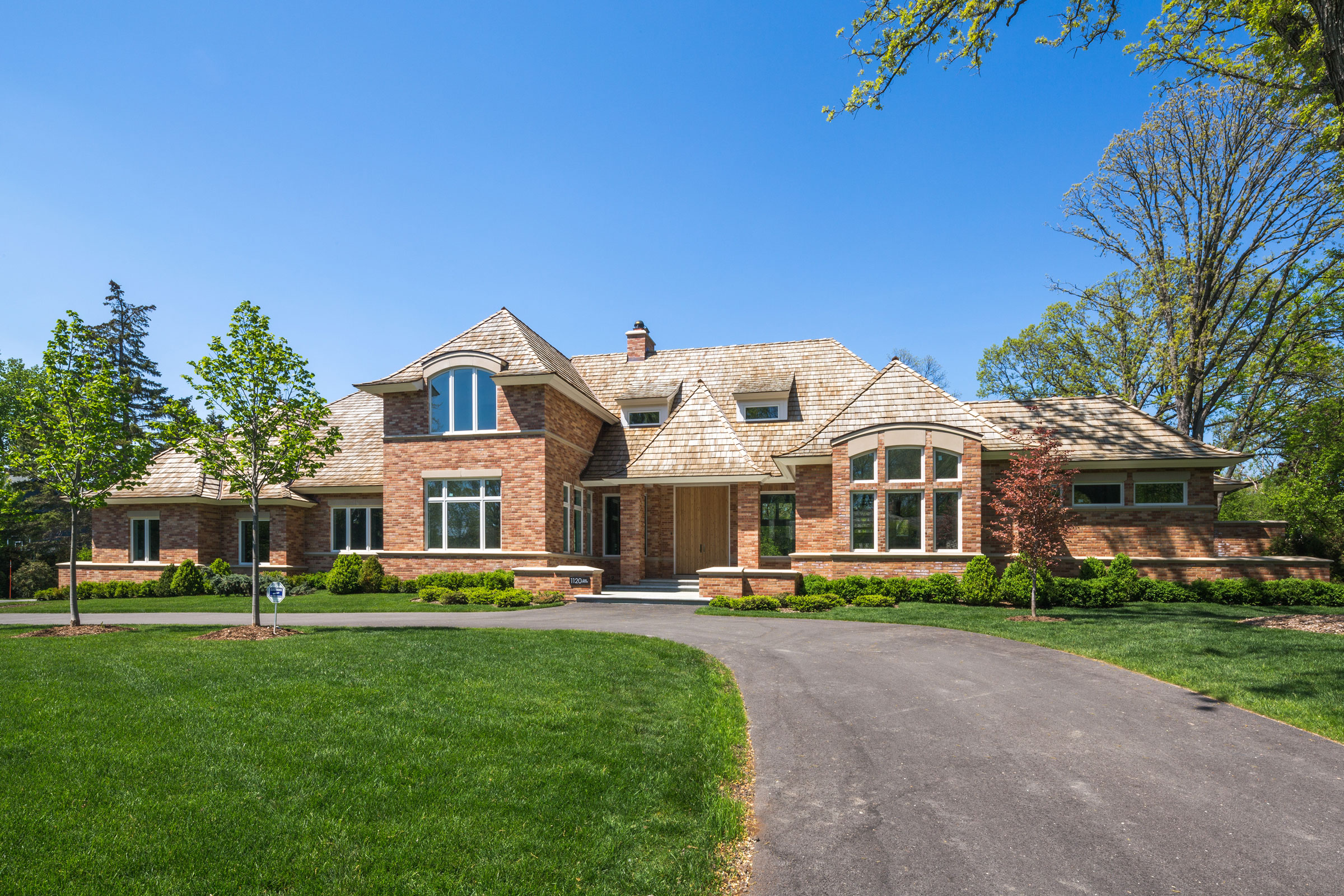
Solid brick is incredibly strong, versatile, and is highly weather, pest, and fire resistant. Thin brick veneer, on the other hand, is lighter, less expensive, and is incredibly easy to install. Photo by Donna Chiarelli
We’ve briefly mentioned the cost and labor differences between brick and thin brick veneers, but let’s take a closer look at how they compare, as well as their respective strengths and weaknesses.
For starters, brick can be used to construct stairs, flooring, chimneys, and solid, load bearing walls due to its high compression strength and overall durability. When used as a cladding material, brick offers excellent protection against the elements, pests, and even fires, but also necessitates highly skilled workers and extends construction times.
Pros of Brick
- Strong and resilient
- Increases home value
- Low maintenance requirements
Cons of Brick
- High upfront costs
- Requires skilled bricklayers
- Lengthy construction process
Thin brick veneer, on the other hand, uses far less material and is much lighter than solid brick, making it much cheaper and allowing for quicker installation times. Because they are thinner than conventional bricks, however, thin brick veneers are more susceptible to cracking and generally have a shorter operational lifespan. They also do not offer the same protection against fire and pests as solid brick does, though they can provide better protection against moisture intrusion and are an extremely energy efficient cladding solution.
Pros of Thin Brick Veneer
- Less expensive
- Easier installation
- Faster construction
Cons of Thin Brick Veneer
- Non-structural
- Susceptible to cracking
- Won’t protect against fire or pests
Brick Home Designs & Inspiration
Here are a few brick residential designs to draw inspiration from.
Brooklyn Mass Timber House, Brooklyn
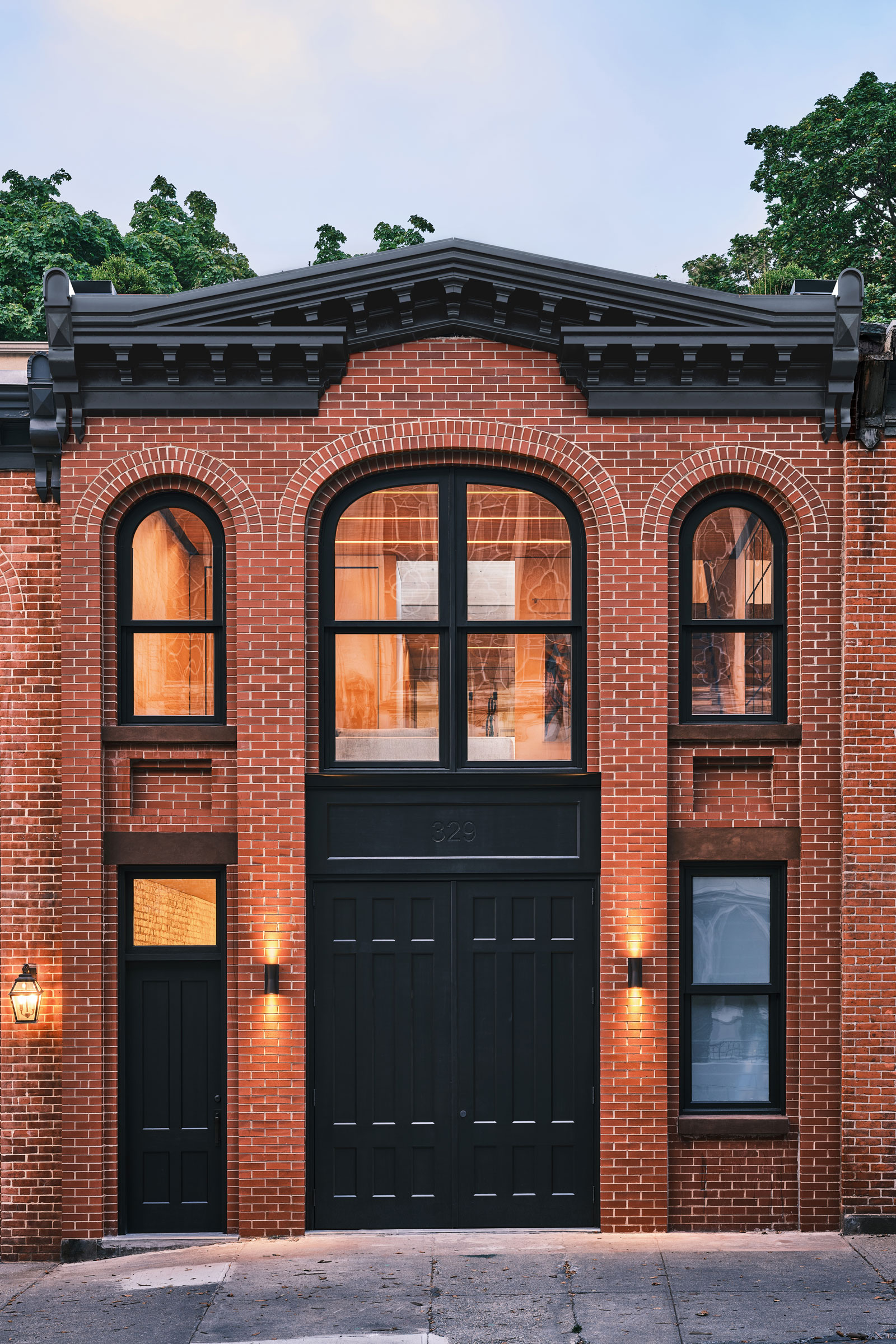
The Brooklyn Mass Timber House project restored an 1870s carriage house’s original redbrick facades and incorporated windows and doors from Mattison Millworks made locally in the Brooklyn Navy Yard. Photo by Frank Frances
Though the name may suggest otherwise, the Brooklyn Mass Timber House expertly showcases how antique brick structures may be adapted and improved upon through the integration of modern materials to create beautiful, sustainable private residences.
Originally built in the 1870s as a carriage house, the Brooklyn Mass Timber House was renovated throughout the early 2020s by Schiller Projects and Acheson Doyle Partners Architects to serve as a permanent home for Aaron Schiller—founder and lead designer of Schiller Projects—and his partner.
Because the building did not share any of its load-bearing masonry walls with adjacent buildings, the design team was able to completely gut the interior, choosing highly-sustainable mass timber as the primary material for the renovation. And while the building’s interior underwent major changes, the original redbrick exterior was left largely untouched, dutifully restored to its former glory according to Landmarks Preservation Committee guidelines. Indeed, the only major alterations were the addition of new arched windows, doors, and dark accents.
La Clairiere, Princeton, NJ
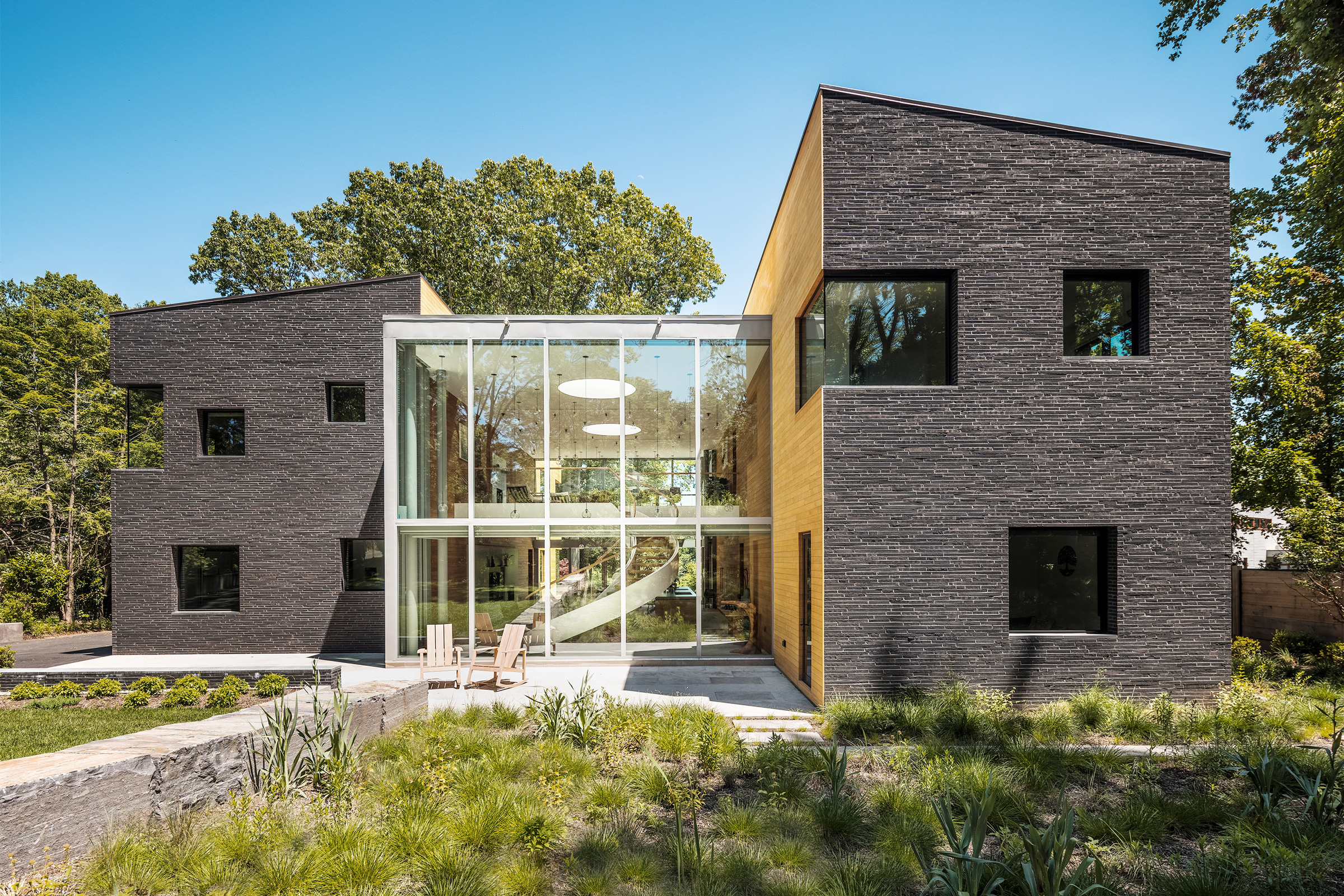
Designed by Studio PHH Architects, La Clairiere house is nestled within a forest of large oaks on the shore of Carnegie Lake. The home uses Black Roman Maximus bricks in its construction. Photo courtesy of Glen-Gery
Located in Princeton, New Jersey and designed by Studio PHH Architects, La Clairiere—or “the Glade” in French—is a two-story single-family residence composed of two solid, brick-clad volumes connected by a central glass atrium.
Studio PHH Architects used elongated Black Roman Maximus bricks manufactured by Glen-Gary for the home’s cladding, chosen for their unique texture, tumbled edges, granular finish, and dark color. Varied lengths of brick were used to help break up continuity in the building’s facade and vertical joints, resulting in a complex, visually-stimulating surface that draws the eye across the home’s entire exterior.
Light-colored wood was used to clad the innermost sections of the two volumes, perfectly contrasting the dark brickwork and complimenting the light-filled glass atrium connecting the two spaces. Such contrast was both an aesthetic choice and a practical one, allowing the home to make effective use of passive solar strategies. “The careful orientation of the dark masses in relation to the glass atrium shelters the space from the southern sun and provides diffuse natural light all day, minimizing the need for artificial lighting,” Pierre-Henri Hoppenot, founder of Studio PHH Architects, wrote in a previous article for gb&d.
The Netsch Residence, Chicago
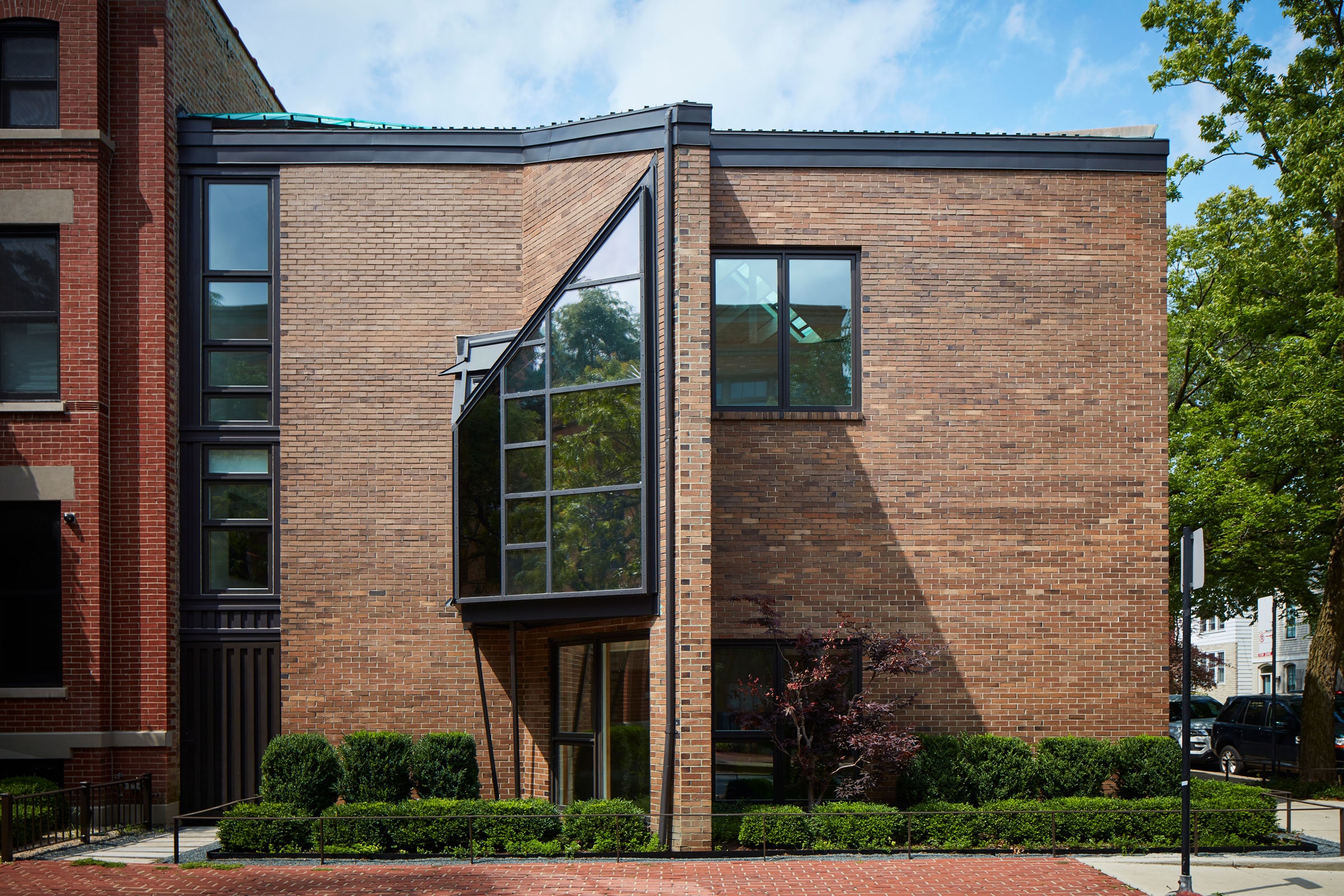
The Netsch Residence in Chicago, renovated by SOM, honors the late SOM design partner Walter Netsch while adding in a modern twist. Photo by Dave Burk
Originally designed by Walter Netsch in 1974 as his own private residence, the Netsch Residence in Chicago was renovated by Skidmore, Owings & Merrill (SOM)—a firm whom Netsch was a design partner of—in the late 2010s for new homeowners Will Forrest and Mark Smithe.
In Chicago’s historic Old Town neighborhood, the Netsch Residence hides a rich variety of interior spaces and carefully designed architectural complexities behind a deceptively inconspicuous brick facade. From the outside the home appears as a simple brick box, accented by a street-facing triangular protrusion. All of the home’s exterior walls are sharply geometric and largely unadorned, clad in a brick veneer featuring a single layer of dark reddish-brown brick over concrete blocks.
Brick House Maintenance Tips

Brick homes are relatively low maintenance but it is still recommended that homeowners regularly inspect for signs of damage and clean exterior walls at least once per year. Photo by Donna Chiarelli
Brick homes are incredibly durable and have an expected lifespan of 100+ years, according to the International Association of Certified Home Inspectors—provided they are properly maintained, that is. As it stands, brick houses are already relatively low maintenance, but the following tips will help keep brick homes looking new for years to come.
Inspect Regularly for Signs of Damage
It is recommended that owners of brick homes inspect exterior walls at least once per year in order to catch potential problems before they become expensive structural issues. Things to look for during inspection include:
- Spalling, flaking, and chipping
- Clogged weep holes
- Crumbling mortar
- Bowing or bulging
- Moss, mold, and mildew
- Water damage
Of these problems, bowing or bulging brick walls are the most severe and are the most likely to result in structural failure or full-on collapse. Fixing a bowed wall typically requires the use of wall anchors and is best left to professional contractors experienced in brick-masonry repairs.
Clean Exterior Walls Annually
Like any exterior-facing material that is regularly exposed to the elements, brick collects dirt, grime, and algae over time. Most experts recommend cleaning brick exteriors annually using either a synthetic or natural brush (just not a wire brush) and a mix of mild detergent and water. Regular cleaning helps prevent the excessive buildup of dirt, moss, and efflorescence that would otherwise require a power washer—which can actually damage the mortar—to remove.
Unclog Weep Holes
All masonry homes, brick or stone, contain weep holes that serve to drain water from the building’s envelope. Weep holes are crucial in preventing moisture buildup that could otherwise lead to rot, mildew, mold, or other forms of water damage and help brick walls retain their structural integrity for the long term.
Over time weep holes can become clogged by sediment, moss, and other unwanted detritus, reducing their efficacy and increasing the chances of moisture retention—which can be especially damaging in winter, as the water may freeze and expand, putting undue stress on the bricks themselves and causing them to crack or split. For this reason it is recommended that owners of brick homes regularly check weep holes on their property to ensure that they are not blocked or clogged, especially after periods of heavy rain. A blocked weep hole can be unclogged using a piece of wire or compressed air.
Keep Plants Trimmed Back
As picturesque as ivy growing up the side of a brick cottage may be, the reality is that allowing vining plants to grow along brick walls can be potentially damaging in the long run. This is especially true of older brick homes that use lime-based mortar, as the specially-formed tendrils—referred to as holdfasts—sent out by plants like English Ivy can actually embed themselves in the mortar, weaken it, and produce cracks as they continue to grow and expand.
Modern brick homes are less likely to be severely damaged by vining plants thanks to the use of strong cement-based mortar, but removing old, well-established vines is still likely to leave behind roots and tightly-adhered holdfasts that are extremely difficult to fully get rid of.
It’s also a good idea to keep plants trimmed back because vines that are allowed to reach roof height can damage gutters or eaves, leading to unnecessary repairs.
Repoint Brickwork When Necessary
While bricks themselves are extremely durable and boast an incredibly long lifespan, the same cannot be said—at least not to the same degree—of the mortar that holds them in place. Regular exposure to the elements causes mortar to deteriorate and crumble over time, allowing bricks to loosen and potentially even fall out entirely. When this happens, the damaged mortar will need to be chipped out and replaced with new mortar, a process known as repointing.
Thanks to the widespread use of cement-based mortar, modern brick homes do not need to be repointed as frequently as older brick homes that employ a lime-based mortar. In either case, however, it is best to leave repointing to a professional mason.



